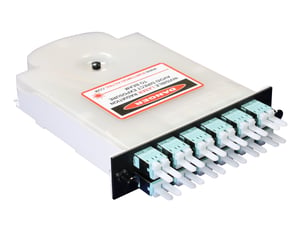Terminating fiber optic cable arguably is the most important step to installing a high performing, long lasting and easy to maintain network. Due to distances and bandwidths increasing, there is no room to take shortcuts to terminate fiber in your network. Over time, the termination methods have improved dramatically by removing as much human error as possible from the process. Let’s walk through today’s options and their strengths and weaknesses.
Jay Sell, Product Manager, Data Center Solutions

The oldest method of field termination is the “puck and polish” method using anaerobic epoxy. The tools required to complete this termination are inexpensive which is attractive to some contractors that may not need to terminate many fibers in their workload. The inexpensive tooling and materials are where the benefits end for “puck and polish”. Dealing with messy epoxy, various grits of polishing paper, and quantity of tools makes the work-space required grow significantly over other methods. The polishing method is highly influential to the quality of the end-face and thus insertion loss and return loss can suffer rather easily. The technician requires a large amount of experience to accomplish this termination in a timely manner (3-5 times slower than a splice-on due to rework and failures) and still not match the performance of the following methods.
Pigtail termination is a faster method due to the polishing and epoxy process being completed in a factory setting ahead of time. Pigtails are sold individually or in ribbon formats making it easy to acquire the correct type for any job. They are inexpensive yet require a splicer and precision cleaver. Also, the splice-points need protection and typically are arranged in a splice tray. This takes some extra time to neatly route the extra fiber and install the splice trays. If the project needs to be added to in the future or reworked for any reason, the extra constraint of the splice trays make this slower and risks damage to existing fibers.
Splice–on connectors are regarded as one of the best methods to terminate a fiber optic cable. In the case of Sumitomo Electric’s LYNX-CustomFIT® 2 Splice-On Connector, the splice point is actually inside the connector avoiding ghost disconnections and fiber breaks at the splice. No splice trays are required saving time in fiber routing and also makes the installation much cleaner providing better airflow to the system. The ferrule is pre-polished from the factory and performance tested to ensure the best connection in the field. A pre-cleaved stub is on the other end of the ferrule and a connector holder is included in the kit making the splice process extremely fast and reliable. There is no judgement required from the technician to continue installation as the splicer is able to diagnose splice issues immediately. Sumitomo splicers are the fastest and give the most accurate splice estimation in the industry saving you valuable time on the job.

Last but not least, splice cassettes bring another level of convenience and performance to fiber termination. Splice cassettes bring together several methods into a single package that is faster, inexpensive and easy to modify/access for future work. Sumitomo’s splice cassette, Fiber Optic eXchange Cassette (FOX), is full of features that are an excellent fit for almost any job. The FOX cassette features a rugged, lightweight ABS body that is wall mountable and can even accept two MPO connectors in the rear entry if required. The cassette is preloaded with fiber pigtails installed into adapters so technicians are not required to handle any connectors in the process eliminating the risk of damage or contamination. The splices are contained in a tidy splice shuttle that can be removed from the cassette to assist in fiber routing and ease of splicing. Two entry points in the rear allow optional routing or dual entrances for multiple fiber cables. A rubber grommet or adhesive foam/ziptie securely hold the entry cable into the cassette making it very resistant to accidental cable pulls from the rear. Incorporating Sumitomo ribbon fiber, the FOX cassette is an attractive option compared to terminating an MPO to a standard MPO cassette. The FOX cassette beats out the MPO method in cost (eliminates two MPO connectors) and performance by using a splice in place of a physical mated pair (up to 0.75dB loss just in the connection). The FOX cassette is available in the industry standard LGX format.
In summary, the options of termination can seem complex and diverse yet when calculating labor time and equipment costs, two methods stand out: Sumitomo LYNX splice-on connectors and Sumitomo’s FOX splice cassette.

